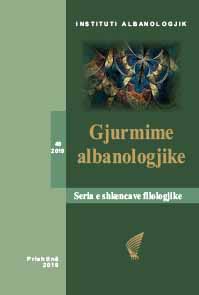MODALITETI DHE KATEGORIZIMI I TRAJTËS LE + LIDHORE
THE MODALITY AND CATEGORIZATION OF LE + SUBJUNCTIVE
Author(s): Ardita BerishaSubject(s): Language studies, Language and Literature Studies, Theoretical Linguistics, Applied Linguistics, Syntax
Published by: Instituti Albanologjik i Prishtinës
Keywords: Albanian language; deontic modality; syntax;
Summary/Abstract: The modality and categorization of le + subjunctive Le + subjunctive is one of the grammaticalized forms of Albanian language, since its first element le is fixed and has become a grammatical particle. Thus, the grammatical markers of per son, number, tense, and voice are taken by the main verb. This grammatical form in Albanian serves to express different modal meanings, which can be interpreted depending on the context in which it is used. It can be used to express permission, request, proposal, plea, advice, and command. As all these modal nuances expressed through le + subjunctive fall within the more general category of directives (Huddleston and Pullum, 2002: 558), this structure belongs to the category of deontic modality. In addition, it is used to express speaker’s indifference or neglect of an action (situation) or a given person (which in the clause can be identified as subject or indirect object). Another function of this structure is its use in conditional or conditional/ jussive clauses. Therefore, a characteristic feature of le + subjunctive is that it is a grammaticalized form and expresses modality. In grammar these two criteria serve as basic criteria to classify a given form as a verb mood, depending on the modality it expresses. Based on these criteria, Breu (2010: 467) considers jussive mood as one of the verb moods of Albanian language. The modality that le + subjunctive expresses is a characteristic feature of the jussive mood (Breu, 2010). Le + subjunctive is a grammaticalized form constructed on the basis of the subjunctive. In the Albanian language it is characteristicthat within the subjunctive mood some other forms are also grammaticalized, such as do + subjunctive, fully grammaticalized, known as the future form, and mund + subjunctive, which preserves the modality of possibility, but takes its grammatical markers only within the form as a whole (its first element mund does not express direct relations to the subject, so both modality and grammatical markers belong to the form as a whole). A weaker degree of grammaticalization is manifested in duhet + subjunctive, which is not grammaticalized (its first element takes grammatical markers of tense duhej). These structures come together in three important points: they express reference to future time, they are consequently modal, and structurally they are built on the basis of the subjunctive. Therefore, they constitute members of the same group, as structures formed on the basis of the subjunctive (or in the case of duhet + subjunctive it tends to become a grammaticalized form). Their modality differs from that of optative, imperative, and admirative moods; compare: shkofsha/shko/shkuaka and do/le/ mund të shkojë (duhet të shkojë also resembles this group but still functions as a free syntactic structure).
Journal: Gjurmime Albanologjike - Seria e shkencave filologjike
- Issue Year: 2019
- Issue No: 49
- Page Range: 155-165
- Page Count: 11
- Language: Albanian
- Content File-PDF

